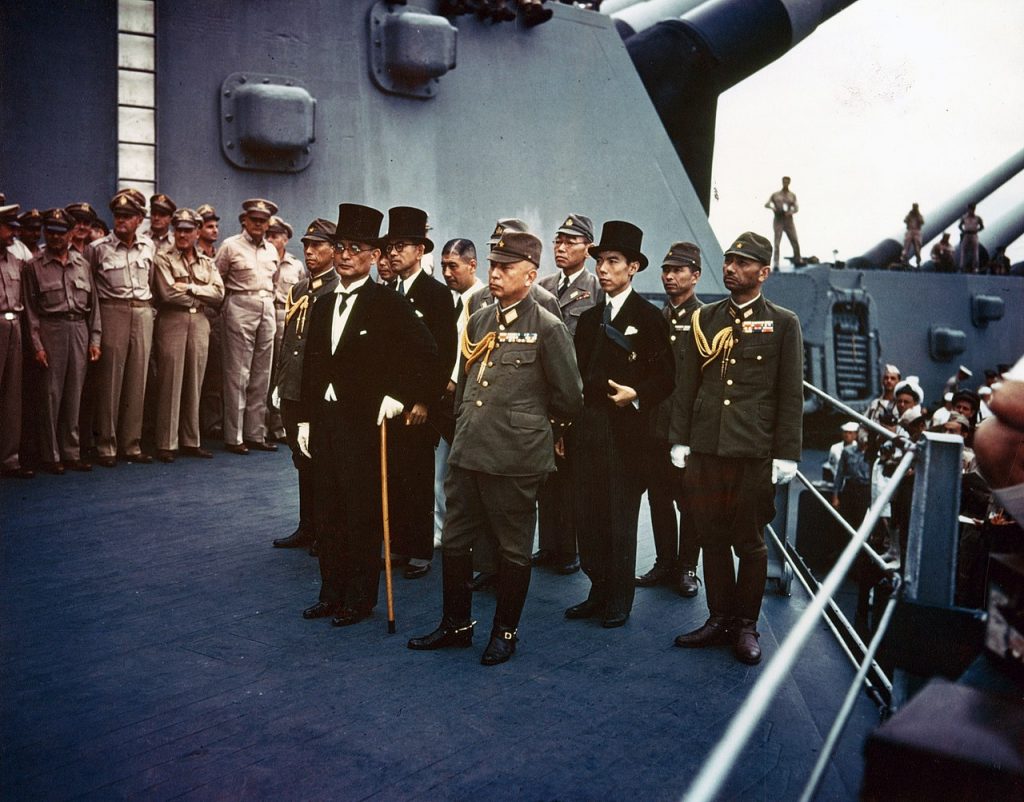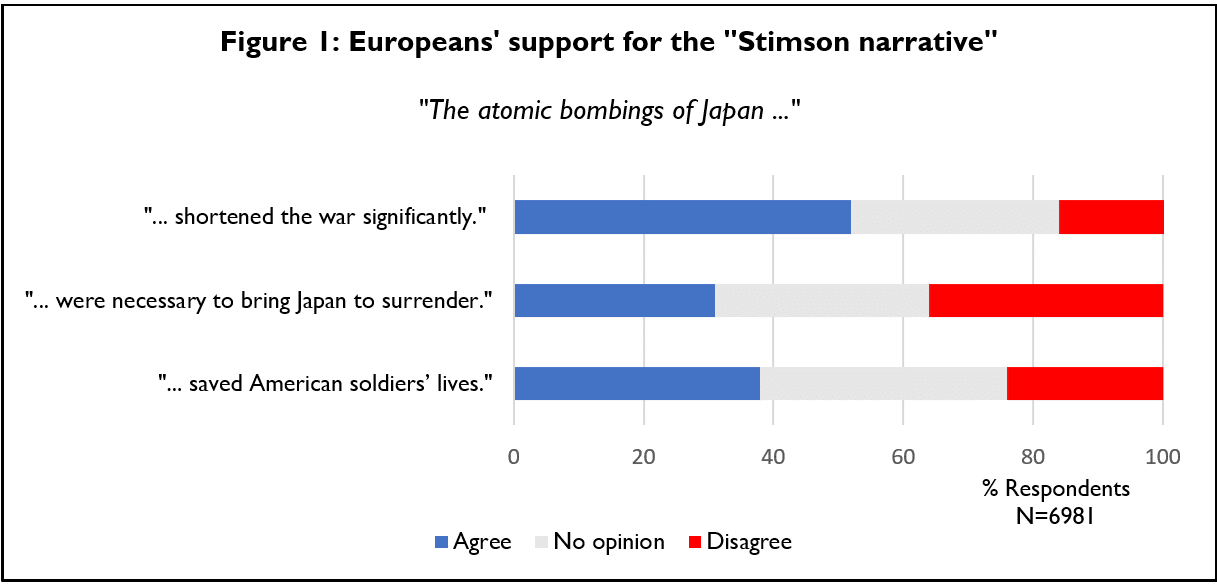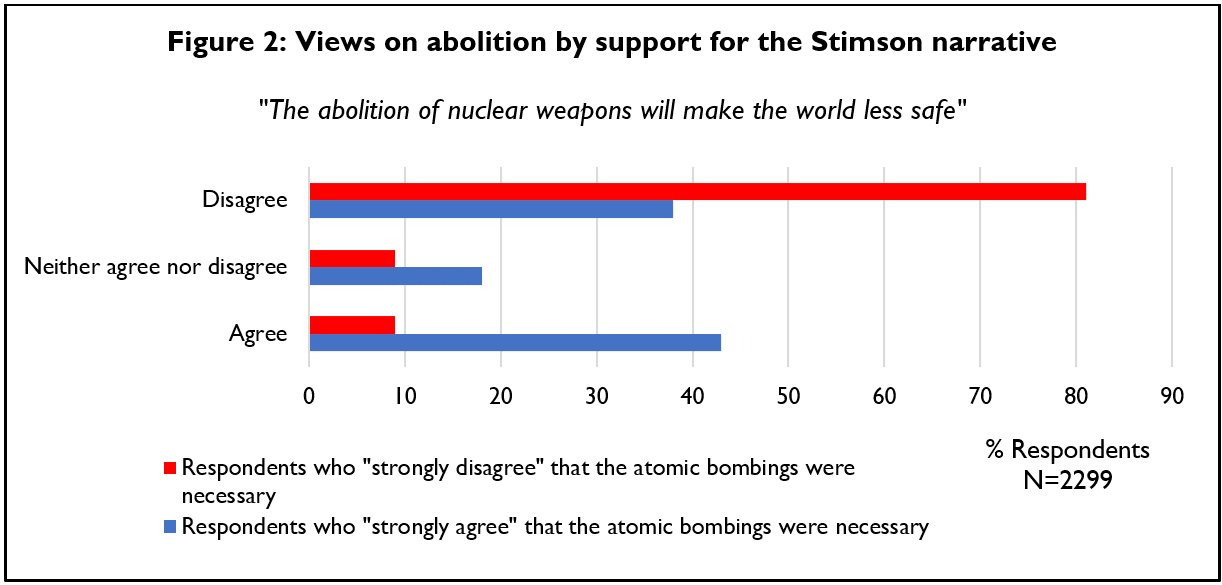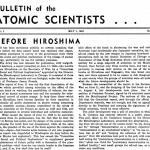What Europeans believe about Hiroshima and Nagasaki—and why it matters
By Benoît Pelopidas, Kjølv Egeland | August 3, 2020

Did the atomic bombings of Hiroshima and Nagasaki shorten the war, and were they necessary to force the Japanese surrender? Many people believe the answer to both questions is yes: In dropping the Bomb, America chose the lesser of two evils.
Although historians have long challenged this narrative as wrong or misleading, a significant number of Europeans still believe it. That is the primary result of a recent survey of European views on nuclear affairs generally and the atomic bombings of Japan specifically. The survey, carried out in October 2019, involved approximately 7,000 respondents aged 18 and upward, carefully selected to ensure representative samples from Belgium, France, Germany, Italy, the Netherlands, Poland, Sweden, Turkey, and the United Kingdom.
The survey also shows that those who believe the bombings were necessary and effective at significantly shortening the war are more likely to harbor skepticism toward nuclear disarmament than those who do not. That being said, European publics remain on the whole staunch in their support for the elimination of nuclear weapons. Even in nuclear-armed France and the United Kingdom, large majorities reject the idea that nuclear weapons could ever be used morally. Although others across the world may hold similar views, to date there has been no broad survey posing these questions in the United States or elsewhere. Future surveys could investigate whether the same pattern exists beyond Europe.
Interrogating the “Stimson narrative.” The debate about the moral acceptability and military necessity of the atomic bombings of Japan began almost immediately after the end of the war. While the American public was broadly accepting of the government’s decision to use the atomic bomb, several commentators criticized it. As the historian Barton Bernstein has documented, this criticism irked many of those responsible for the bomb’s development and use. The result was a coordinated campaign by a handful of wartime atomic policy makers, aimed at demolishing “the wrong kind of thinking.” Among the most influential contributions to this campaign was former US Secretary of War Henry Stimson’s February 1947 article in Harper’s Magazine, “The Decision to Use the Atomic Bomb.” Stimson’s article, as well as his memoir, published with McGeorge Bundy in 1948 (Bundy was also the uncredited co-author of the Harper’s piece), provided a starting point for historians seeking to make sense of the decision-making process that led to the atomic bombings in August 1945.
The story told by the former secretary of war and his allies was the following: After careful deliberation, American authorities decided that the use of atomic bombs would be the lesser of two evils. According to Stimson’s calculation, the choice to use atomic weapons was “a decision that brought death to over a hundred thousand Japanese.” However, Stimson argued, the bombings spared America, her allies, and the world at large of what would inevitably have been a gruesome invasion of the Japanese home islands. “I was informed,” Stimson wrote, that an invasion “might be expected to cost over a million casualties, to American forces alone. Additional large losses might be expected among our allies, and, of course, if our campaign were successful and if we could judge by previous experience, enemy casualties would be much larger than our own.” Ultimately, the destruction of Hiroshima and Nagasaki “put an end to the Japanese war.”
The Stimson narrative has since been challenged by several historians on multiple grounds. First, it does not appear that the US executive spent much time deliberating whether atomic weapons should be used or not. Discussions instead focused on how, when, and where they would be employed.
Second, Stimson’s utilitarian calculation appears to be based on numbers overly flattering to his own case. According to declassified documents, the US military estimated in June 1945 that a full-scale invasion of the Japanese home islands, in the worst-case scenario, could be expected to incur up to 220,000 casualties—quite far from Stimson’s “over a million.” Moreover, of the 220,000 casualties, only 46,000 were projected as fatalities. The number of people killed in Hiroshima and Nagasaki, on the other hand, was probably at least twice as high as the “over a hundred thousand Japanese” reported by Stimson in 1947.
Third, the idea that the US government was faced with only two options in August 1945—full invasion or atomic bombing of Japanese population centers—has little basis in reality. Alternative courses of action, not mutually exclusive, would have included negotiations, a demonstration of the atomic bomb in an uninhabited area, continued strategic bombing short of the use of atomic weapons, continued economic blockade, and waiting for the Soviets to declare war against the Japanese empire.
Fourth, it is not clear that the atomic bombs were in fact responsible for the Japanese surrender. The Japanese war cabinet had over an extended period of time been divided between a “peace party,” which argued that Japan should seek an end to the war as quickly as possible, and a “war party,” which argued the war should be continued as Japan sought good offices from the Soviet Union to negotiate a peace deal with the United States and Britain. In the view of the acclaimed historian Tsuyoshi Hasegawa, who consulted primary sources in Japanese, it was the Soviet Union’s breach of the Soviet–Japanese Neutrality Pact and attack against Japan on August 9, 1945 that tipped the scale and forced the emperor’s decision to surrender the very next day (the final decision was formalized a few days later, following discussions within the Japanese executive). In the absence of the Soviet invasion, Hasegawa concludes, the two atomic bombs would “most likely not have prompted the Japanese to surrender, so long as they still had hope that Moscow would mediate.”
The historian John Dower concurs: The Soviet entry into war was more important than the atomic bombing in producing Japanese surrender. Once the Soviets intervened, the Japanese appear to have favored surrendering to Washington over allowing Moscow to conquer their country. At the same time, from the perspective of the Japanese government, the atomic bombings provided an opportunity to frame the Japanese military’s shattering defeat as a result not of its own incompetence, but as an outcome of the introduction of a new and revolutionary weapon by the enemy. In Dower’s words, the atomic bombings allowed the Japanese emperor to spin the capitulation as “nothing less than a magnanimous act that might save humanity itself from annihilation by an atrocious adversary.”
In fact, according to the US Air Force’s own review, finalized not long after the end of the war, Japan would likely have surrendered that same autumn even in the absence of atomic bombings or an invasion. Similarly, the Joint Chiefs of Staff expressed skepticism about the use of atomic bombs both before and after the fact.
In summary, many of the central claims on which the official story about Hiroshima and Nagasaki is founded—that the atomic bombings were necessary to end the war, that they ended a conflict that otherwise would have slogged on, and that they saved a large number of American soldiers’ lives—appear to rest on shaky ground. While certain aspects of the story stand up to scrutiny, others have been proven plain wrong, and others remain contested by scholarship. But have people caught up with the historiography?
European views on the atomic bombings of Japan. Asked to note their agreement or disagreement with the statement that “the atomic bombings of Japan in World War II shortened the war significantly,” 23 percent of respondents to the October 2019 survey “strongly” agreed, 29 percent “somewhat” agreed, 31 percent reported no opinion, 9 percent “somewhat” disagreed, and 8 percent “strongly” disagreed. In other words, while 52 percent of respondents expressed support for the idea that the war was significantly shortened by the atomic bombings, only 17 percent pushed back against that idea.
Regarding the question of whether “the atomic bombings of Japan in World War II were necessary to bring Japan to surrender,” the survey results were more balanced. 12 percent of respondents “strongly” agreed, 19 percent “somewhat” agreed, 33 percent reported no opinion, 15 percent “somewhat” disagreed, and 21 percent “strongly” disagreed.
On the statement, “The atomic bombings of Japan in World War II saved American soldiers’ lives,” 14 percent of respondents expressed that they “strongly” agreed, 25 percent that they “somewhat” agreed, 38 percent reported no opinion, 11 percent expressed that they “somewhat” disagreed, and 13 percent expressed that they “strongly” disagreed.
Finally, asked to note their agreement or disagreement with the statement that “the atomic bombings of Japan in World War II killed innocent civilians,” 71 percent of respondents to the 2019 survey “strongly” agreed, 14 percent “somewhat” agreed, 12 percent expressed no opinion, and less than 5 percent “strongly” or “somewhat” disagreed.
The results suggest that the Stimson narrative still holds sway among Europeans, but that support might be weakening over time. On each statement, older respondents were slightly more likely than younger respondents to express agreement with Stimson’s interpretation of the atomic bombings.
Finally, it bears mentioning that British respondents stand out among the nine European populations sampled as the greatest believers in the Stimson narrative. The results unfortunately do not give further insight into the causes of this tendency, but three mutually reinforcing hypotheses are plausible. First, the shared language of the United States and the United Kingdom allows narratives and talking points to travel relatively frictionless across borders. Second, the United Kingdom was directly involved in the building of the atomic bomb through the Manhattan Project and, by extension, partly responsible for the fates of the people of Hiroshima and Nagasaki. Patriotic Brits may therefore be more susceptible to wishfully thinking that the bombings were decisive in ending the war and saving lives. An indication of this may be that, according to the survey data, Brits who express disagreement with the statement “I see myself as part of the European Union” are significantly more likely to subscribe to the constitutive claims of the Stimson narrative. Third, the same kind of mechanism could operate vicariously through the US–British “special relationship”: British respondents, through affective identification with the US position, were predisposed to accepting the narrative that the bombings were meaningful and thereby justified. It is notable that the British public holds significantly stronger support for the Stimson narrative than do the French—citizens of Western Europe’s other nuclear-armed state.
Attitudes toward nuclear disarmament. European publics have long offered strong support for arms control and the elimination of nuclear weapons. This pattern is further corroborated by the survey data, which show consistent support for nuclear disarmament. While 74 percent of respondents expressed support for “an international agreement for eliminating nuclear weapons,” only 6 percent expressed opposition (the rest reporting no opinion). On the statement “It is desirable to eliminate all nuclear weapons worldwide within the next 25 years,” 60 percent expressed “strong” agreement and 20 percent agreed “somewhat.” And while 13 percent expressed that they neither agreed nor disagreed, only 7 percent “strongly” or “somewhat” disagreed.
The support for disarmament is robust and consistent: 81 percent of respondents who strongly agreed with the goal of eliminating nuclear weapons within 25 years also offered strong support for an agreement to eliminate nuclear weapons. Perhaps unsurprisingly, of the populations sampled, enthusiasm for the goal of disarmament was highest in Germany, where 76 percent “strongly” agreed with the notion that the elimination of nuclear weapons would be desirable, and lowest in France, where about half the population, 49 percent, expressed “strong” agreement (and an additional 28 percent agreeing “somewhat”).
However, there is clear relationship between degree of faith in the Stimson narrative and support for the abolition of nuclear weapons. Respondents who said the atomic bombings shortened the war significantly, were necessary to bring about the Japanese surrender, or saved American soldiers’ lives were significantly more likely to believe that the abolition of nuclear weapons would “make the world less safe” compared to those who did not express such views.
For example, among respondents who expressed “strong agreement” with the idea that the atomic bombings were “necessary” to bring the war to an end (12 percent of the total number of respondents), 43 percent agreed that abolition would make the world less safe and 38 percent disagreed. By contrast, among respondents who expressed “strong disagreement” with the notion that the atomic bombings were necessary (22 percent of the total number of respondents), only 9 percent agreed that abolition would make the world less safe while 81 percent disagreed.
On the question of which strategies states without nuclear weapons should use to protect themselves in a nuclear-armed world, believers in the Stimson narrative were also significantly less likely to pick “Advocate for the abolition of nuclear weapons” as one of their favored options. (Other options included “seek protection by the nuclear weapons of their allies,” “develop their own nuclear weapons for self-defense,” “receive guarantees that nuclear weapons will never be used against them,” “build a strong conventional arsenal but not nuclear weapons,” and “request protection from allies without asking for the use of nuclear weapons.” Multiple answers were possible.) Conversely, respondents who do not accept the Stimson narrative were more likely to pick advocacy for abolition as a reasonable security strategy for non-nuclear-weapon states.
The data also show statistically significant correlations between, on the one hand, the beliefs that the atomic bombings saved American soldiers’ lives and were necessary to force the Japanese to surrender, and, on the other, lower levels of support for the statement that “it is desirable to eliminate all nuclear weapons worldwide within the next 25 years.” Those who believe the bombings were necessary and saved American soldiers’ livers are also more likely than those who do not hold such views to disagree with the statement, “I support an international agreement for eliminating all nuclear weapons.”
All of this said, however, a majority of respondents, including a majority of believers in the Stimson narrative, favor abolition. In other words: Most believers in the Stimson narrative do not oppose disarmament, but most opponents of disarmament believe in the Stimson narrative.
Asked whether there are “any circumstances in which the use of nuclear weapons is morally acceptable” (a question that was only asked of French and British respondents), 79 percent responded that “it is never morally acceptable to use nuclear weapons.” Only 21 percent responded that, “under certain circumstances, it might be morally acceptable to use nuclear weapons.” This may be taken as an indication that support for the Stimson narrative does not translate into moral support for the use of nuclear weapons in the future.
But for those who maintain that nuclear weapons might be used morally, which conditions do they identify as valid for the use of such arms? Of the 21 percent of respondents who expressed that the use of nuclear weapons might be morally acceptable under certain circumstances, 50 percent submitted “If the existence of my country is in peril,” 45 percent submitted “As a response to a nuclear strike,” 16 percent submitted “If an allied country is attacked,” and 35 percent submitted “To defeat terrorist groups.” 45 percent—amounting to 9 percent of all respondents—submitted the scenario that most resembles the Stimson narrative about the atomic bombings of Japan: “To end a war, if doing so saves lives.”
Future memories of Hiroshima and Nagasaki. A last but crucial question is whether memories of Hiroshima and Nagasaki are likely to endure in the future. Asked to identify which city or cities were bombed with nuclear weapons during World War II, 85 percent of respondents to the 2019 survey correctly identified Hiroshima and 67 percent correctly identified Nagasaki.
There is, however, a notable correlation between being able to identify the correct cities and age; older respondents are more likely than younger respondents to know that Hiroshima and Nagasaki were targeted. For example, while 80 percent of respondents aged 70 or older correctly identify Nagasaki as having been bombed, only 53 percent of respondents under the age of 20 were able to remember Nagasaki. The fact that Nagasaki is less frequently identified than Hiroshima in every country (the difference amounts to 18 percent of respondents overall and varies from 11 to 23 percent depending on the country) may have an impact on the meaning people assign to atomic weapons and bombings, which vulnerabilities they take into account, and the possibilities for the future development of nuclear policy.
Beyond accuracy’s sake, recent discoveries about Nagasaki bring an important dimension to nuclear politics that is often overlooked: the vulnerability of nuclear command and control and the role of luck in the outcome of nuclear events. While the attack on Hiroshima was well planned and executed, the opposite is true for the one on Nagasaki, which was originally just a secondary target and ended up being struck by a bomber heading for Kokura. The causes of that in-flight change remain debated, but even years later, the head of the Manhattan project, Lt. Gen. Leslie Groves, was not able to understand why Nagasaki ever became the target. Even after the change, ground zero ended up being some three-quarters of a mile off target.
So, remembering Nagasaki opens up a space for thinking about the vulnerability of the command and control of nuclear operations and the possible role of luck in some of their outcomes. Whether or not Nagasaki features in the narrative can shift the memory of the bombings from a story of strategic rationality, calculated decision making, and military planning and implementation to a story of errors, contingency, and bad luck for Nagasaki and good luck for Kokura.
While the bombings of Hiroshima and Nagasaki are often portrayed as the epitome of the material vulnerability of human societies to nuclear weapons, those societies are also vulnerable to forgetfulness, misremembering, and myth-making, creating a gap between warranted and actual levels of confidence in particular claims. Seventy-five years after the events—and in spite of the progress of historical scholarship—the Stimson narrative continues to hold sway among large sections of the public, shaping views on nuclear policy issues. By contrast, nuclear close calls and enduring weaknesses in the command and control of nuclear operations dating back all the way to the bombing of Nagasaki tend to be overlooked. It is the responsibility of scholars and educators to work against such epistemic vulnerability to expose citizens to the latest advances of knowledge so that they can independently form their political views.
Funding note: This project has received funding from the European Research Council (ERC) under the European Union’s Horizon 2020 research and innovation program (grant agreements 759707 and 841764)
Together, we make the world safer.
The Bulletin elevates expert voices above the noise. But as an independent nonprofit organization, our operations depend on the support of readers like you. Help us continue to deliver quality journalism that holds leaders accountable. Your support of our work at any level is important. In return, we promise our coverage will be understandable, influential, vigilant, solution-oriented, and fair-minded. Together we can make a difference.
Keywords: Europe, Hiroshima and Nagasaki, World War II, polls
Topics: Analysis, Hiroshima & Nagasaki, Nuclear Risk
Share: [addthis tool="addthis_inline_share_toolbox"]


















This old debate misses some unexplained realities. The Russians had no real navy. They could grab China but could not invade Japan–an island nation that exists because it is a set of offshore islands and hard to invade as shown by a thousand years of history.. It would have taken far longer for the Russians to build a fleet to invade Japan than the American conquest of Japan. The Japanese were well aware of these realities. If there had been no cold war, would anybody have seriously considered the Russian attack as decisive? Are we interpreting reality in hindsight to… Read more »
You omit one obvious reason why British respondents should favour the Stimson narrative. Britain was an active combatant in the area (and, of course, the only one of those European countries not occupied, neutral, or on the Axis side). Many thousands of British captives (both military and civilian) were brutalized by the Japanese. Many died as a result of forced labour and malnutrition. At the end of the war Japan had around 100 000 Allied POWs in the home islands and their lives were in the balance. Maybe you should ask the Europeans their views on the possible use of… Read more »
Great analysis – but I personally think there is one glaring ommission: The use of the bomb on Hiroshima and Nagasaki made the weapon real. Even as world powers scrambled to build nuclear arsenals to ‘protect themselves’ – no one could ever lose sight of the image of the effects of actually using them. For the greater good of humanity, that there has always been a strong abolitionist movement against nuclear armaments might be the greatest legacy of the suffering experienced in these two cities and the nation of Japan
Hmmm. It’s too easy to develop an armchair analysis decades later and it is obviously motivated by quite different contingencies. The mythologies of western liberalism and the generic individual call for all lives to valued equally; the logic of war discounts enemy casualties, for reasons that should be obvious. To me, that’s more of a reason for avoiding war. It seems crazy to me to imagine that the US command could, would, or should choose a path that would prolong the war for an indefinite period and produce an unknown but likely huge number of US and allied casualties. I… Read more »
Sir,
Thank you for this response; it is spot on. President Truman was never told of the Manhattan Project as Vice President. When FDR died, Sec’y of War Harold Stimson explained it to him; he also told him of the expected fatalities from Operation Downfall, the planned 1- to 2-year assault on the Japanese mainland. These were 500,000-to-1 million US and Allied deaths and 8-to-10 million Japanese deaths. Little Boy and Fat Man actually saved millions of US and Japanese lives.
Dr. T. Douglas Reilly, Los Alamos, New Mexico
Did you read the article? You only restated the points that the authors rebutted.
In their article “What Europeans believe about Hiroshima and Nagasaki—and why it matters” Benoît Pelopidas and Kjølv Egeland argue that the bombing of Hiroshima and Nagasaki was unjustifiable, not only morally or legally, but militarily, in that Japan likely would have surrendered quite soon anyway. I want to draw into question not so much Pelopidas and Egeland’s conclusions, but their sense of certainty. There is no question that the atomic bombing of the two cities in Japan in 1945 was an act of extreme brutality and cruelty. As well, very few would disagree that nuclear weapons must never be used… Read more »
Stalin had committed to entering the Pacific War within 90 days of the end of the war in Europe; he upheld his commitment to his allies. But that is neither here nor there: The point is that the Japanese had turned the Pacific Campaign into an unimaginable bloodbath in island after island, concluding with Okinawa, with 12,000 U.S. deaths. Anyone who thinks that an invasion of the Japanese home islands would have been less than 10-to-20 times that number is willfully disregarding the unmistakable message sent to the U.S. during that campaign. The military estimate of 46,000 comes from the… Read more »